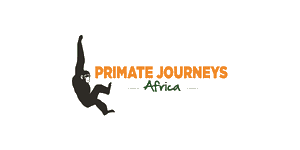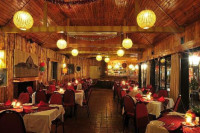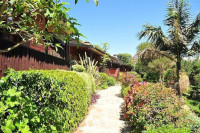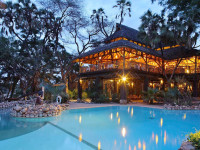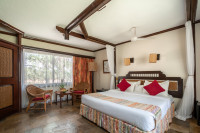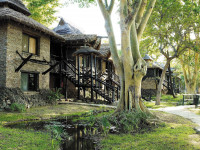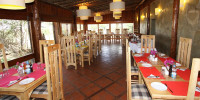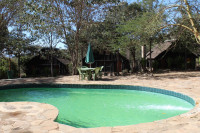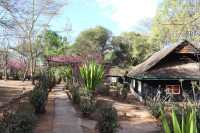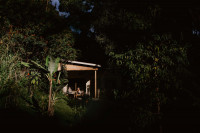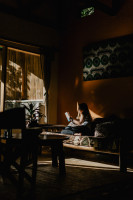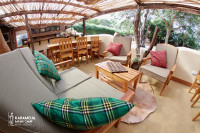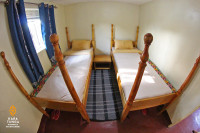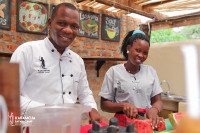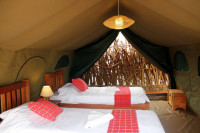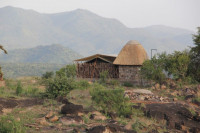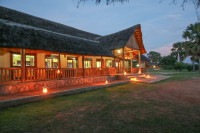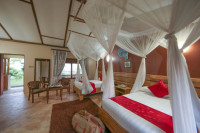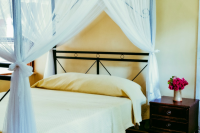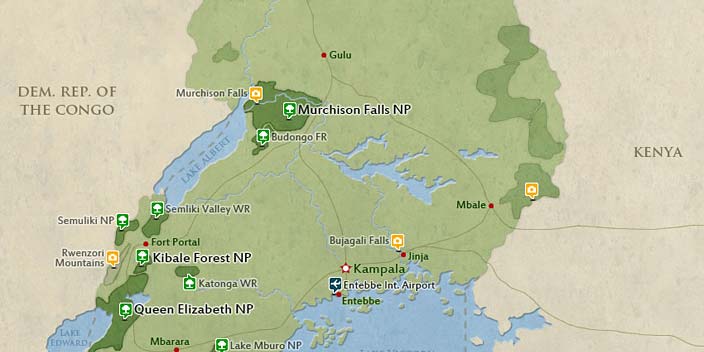
Arrival
Arrival

Day 1
Nairobi - Naro Moro
Nairobi - Naro Moro
Depart from Nairobi in the morning and proceed through extensive farmland towards the cool slopes of Mt. Kenya with several stops en route. Picnic lunch. In the late afternoon, arrive at Naro Moru. the drive may be a bit long but quite interesting with a lot of sight seeings, then have an Overnight at Naru Moru.
- Main Destination:
- Mount Kenya (Kenya)
- Accommodation:
- Naro Moru River Lodge
- Meals & Drinks:

Day 2-3
Isiolo – Buffalo Springs & Samburu Reserves – Shaba National Park
Isiolo – Buffalo Springs & Samburu Reserves – Shaba National Park
We cross the Equator and stop in Isiolo for refuelling. These 2 days are spent in the 3 national reserves of Buffalo Springs, Samburu and Shaba that form a block of conservation area in the remote Central Northern Kenya. The lifeline of these reserves is the Ewaso Ngiro River, the “River of brown waters”.
Buffalo Springs Reserve lies to the south of Samburu. The two are separated by the Ewaso Ngiro River, and share the same ecosystem. An unexplained phenomenon is the presence of the Common Zebra in Buffalo springs and the absence of the species in the Samburu, just across the river.
Shaba National Reserve takes its name from a massive cone of volcanic rock that dominates the region. The lifeline of the park is Ewaso Ngiro River, lined with doum palms, which forms its Northern boundary. In addition to the river, the reserve has four springs, thus making it better watered. Having more water than her neighbours, Shaba has plenty of game and birdlife.
- Main Destination:
- Shaba National Reserve (Kenya)
- Accommodation:
- Sarova Shaba Game Lodge
- Meals & Drinks:
Day 4-5
Borana – Samburu – Matthew Range – Wamba – Barsaloi – Maralal – Kissima
Borana – Samburu – Matthew Range – Wamba – Barsaloi – Maralal – Kissima
The Borana pastoralists are part of a large Cushitic group, also referred as Oromo, having migrated from the southern highlands of Ethiopia in the 1500's. They live in a large area of the barren Northern Kenya with Isiolo being their most southern grazing grounds. Proud women and men live a hard semi nomadic life watering their camel and cattle herds in the Ewaso Ngiro River.
The Samburu are related to the Maasai and live in the northern semi-arid areas of the Matthews Range, the Ndoto Mountains and surrounding plains. They have a pastoral lifestyle and get blood from their camels rather than their cattle. The name Samburu means "butterfly". Society is interwoven by relationships of blood, and by bond. On our way to Wamba, we will stop at Samburu manyattas and with a bit of luck we will witness ceremonial dances. We can see Grevy's zebras, Gerenuks, Grant’s gazelles, Dikdiks, and Ostriches.
- Main Destination:
- Maralal National Sanctuary (Kenya)
- Accommodation:
- Maralal Safari Lodge
- Meals & Drinks:

Day 6
Lake Baringo to Pokot
Lake Baringo to Pokot
A wide track leads toward Lake Baringo. This is Pokot country. The Pokot society is governed through a series of age grades. The Pokot are mostly cattle herders, some are cultivators, mostly growing corn. However, whether a cultivator or pastoralist, the measure of wealth among the Pokot is determined by the number of cows one owns. Cows are used for barter, and exchange, which further goes into "bride wealth".
- Main Destination:
- Lake Baringo (Kenya)
- Accommodation:
- Soi Safari Lodge
- Meals & Drinks:

Day 7
Kitale – Mount Elgon – Uganda
Kitale – Mount Elgon – Uganda
We stop at Kitale, a good-sized town in the western highlands, a very productive agricultural area. Lying just one degree north of the equator, the forested slopes, ice-cold streams, and volcanic shape of Mount Elgon, a huge and extinct volcano formed during the colossal upheaval, which created the Great Rift Valley, make a fascinating contrast with the bushy semi arid plains. The road winds toward the border then drops again away to the arid semi-deserts of north eastern Uganda with an unforgettable view on Sippi Falls.
- Main Destination:
- Sipi Falls (Highlight, Uganda)
- Accommodation:
- Sipi River Lodge
- Meals & Drinks:

Day 8
Pian – Upe – Nakapiripirit – Moroto – Karimojong
Pian – Upe – Nakapiripirit – Moroto – Karimojong
The Karamojong or Karimojong, are an ethnic group of agro-pastoral herders. Their language is also known as Karamojong and is part of the Nilo-Saharan language group. According to anthropologists, the Karamojong are part of a group that migrated from Ethiopia around 1600 A.D. Their main livelihood activity is herding livestock, which has social and cultural importance. Crop cultivation is a secondary activity, undertaken only in areas where it is practicable. Due to the arid climate of the region, the Karamojong have always practiced a sort of pastoral transhumance, where for 3-4 months in a year, they move their livestock to the neighbouring districts in search of water and pasture for their animals. Overnight in Karamojong.
- Main Destination:
- Mount Moroto (Uganda)
- Accommodation:
- Kara-Tunga Safari Camp
- Meals & Drinks:

Day 9
Kotido – Kaabong – Ik, The Mountain People
Kotido – Kaabong – Ik, The Mountain People
In the far north east out of Kaabong, in the mountains that offer a magnificent view toward the Kenyan arid plains rolling to Lake Turkana, stay the Ik, also known as the Mountain people. The Ik live in several small villages arranged in clusters, which comprise the total "community". Each small village is surrounded by an outer wall, and then sectioned off into familial neighbourhood called Odoks, each surrounded by a wall. Each Odok is sectioned into walled-off households with front granaries.
- Main Destination:
- Kidepo Valley National Park (Uganda)
- Accommodation:
- Kaabong Resort
- Meals & Drinks:

Day 10-11
Kidepo Valley National Park
Kidepo Valley National Park
Leaving the mountains, we drive north through extensive grass plains and reach one of the less visited park in Uganda. Kidepo Valley National Park is one of Uganda's most spectacular areas. Tucked into the corner of the country's border with Sudan and Kenya, it offers breathtaking savannah landscapes, which end in rugged horizon. Wide climatic conditions have evolved an extremely diverse flora. As a result, the variety of animal species in the park is equally abundant including many, which are found nowhere else in Uganda. Kidepo Valley harbours a much greater diversity of animal species than other parks.
Carnivore species unique to Kidepo and Karamoja region include the bat-eared fox, striped hyena, aardwolf, caracal, cheetah and hunting dog. Less common ungulates include the greater and lesser kudu, Chandler’s mountain reedbuck, klipspringer, dikdik. Carnivores present include lion, leopard, several small cats, spotted hyena, black-backed jackal and side-striped jackal.
- Main Destination:
- Kidepo Valley National Park (Uganda)
- Accommodation:
- Kidepo Savannah Lodge (Safari Tent)
- Meals & Drinks:
Day 12
Kidepo – Acholi Villages – Kitgum
Kidepo – Acholi Villages – Kitgum
Westwards through the Nangeya Mountains and cross the fertile land of the Acholis dotted with big villages. The Acholi are a Luo people, who are said to have come to northern Uganda from the Bahr el Ghazal area in southern Sudan. Their traditional villages are formed of circular huts with a high peak, with the walls daubed with mud and decorated with geometrical designs in red, white or grey. Overnight in Kitgum.
- Main Destination:
- Kitgum (Town, Uganda)
- Accommodation:
- Bomah Hotel Kitgum
- Meals & Drinks:

Day 13-14
Gulu - Murchison Falls
Gulu - Murchison Falls
Via Gulu, we reach Murchison Falls NP at the end of the morning. Entering the park from the north east, we cross rolling grassy plains where the game is concentrated. The Ugandan cob is the most commonly seen antelope; the hartebeest and oribi are also common. Among the thousands of birds, we must mention the Abyssinian hornbill and the rare shoebill stork. We drive to the lakeside area, watering hole for elephant and Rothschild giraffe, and spend a last night under canvas where the Nile quietly rejoins the vast waters of Lake Albert.
The next day, after a morning game drive, we check in at Paraa Lodge superbly located on a hill overlooking the majestic River Nile. In the afternoon, wetake to the water in a boat to get a closer look at the waterfalls and to enjoy a unique opportunity to observe the thousands of vibrantly coloured birds, herds of buffalo at the water’s edge and crocodiles sunbathing on the riverbanks.
- Main Destination:
- Murchison Falls National Park (Uganda)
- Accommodation:
- Pakuba Safari Lodge
- Meals & Drinks:
Day 15
Nile Falls – Chimpanzees Of Kanyo-Pabidi – Masindi Hotel
Nile Falls – Chimpanzees Of Kanyo-Pabidi – Masindi Hotel
A ferry crosses the wide river. On our way to Budongo Forest, we stop at the Kabalega Waterfalls that are undeniably one of the most remarkable sights in the park. They were named after a Munyoro chief who put up fierce resistance to the European explorers and the Sudanese slave traders looking for the source of the White Nile. Here, the river makes a path across a narrow gorge and unleashes millions of litters of water over the edge of a 43m high precipice.
In the early afternoon, at Kanyo Pabidi, in the Budongo forest we track the chimpanzees. Budongo Forest has the largest mahogany forest in East Africa and probably also the largest chimpanzee population in Uganda. Research on chimps started there in 1960. There are two communities habituated for tourists and one for research. Overnight in Masindi.
- Main Destination:
- Kaniyo Pabidi Forest (Budongo Forest, Uganda)
- Accommodation:
- Masindi Hotel
- Meals & Drinks:

Day 16
Masindi – Kampala – Departure
Masindi – Kampala – Departure
We pass vast cattle farms where long-horned cattle drink from scarce water holes. The fields of maize and cassava slowly give way to other crops such as banana trees and yams, which need more water. And finally, we approach Kampala, the “Hill of the Impalas” in Luganda. Kampala is the capital city of Uganda with over 1.5 million inhabitants, and has an architectural style that reflects the diverse ethnic origins of its population. Mosques with their minarets pointing to the sky and Sikh temples flaunting their decadent sculptures, while the Roman Catholic cathedral displays an airy façade and the Anglican church brings back memories of Victorian propriety. In the late afternoon transfer to Entebbe airport.
- Main Destination:
- Entebbe International Airport (Entebbe, Uganda)
- Accommodation:
- No accommodation (End of tour)
- Meals & Drinks:

